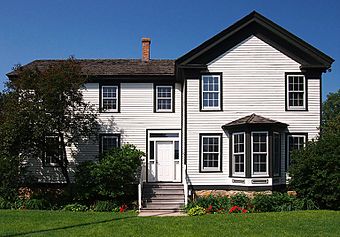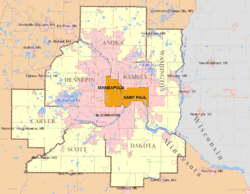Banfill Tavern facts for kids
Quick facts for kids |
|
|
Banfill Tavern
|
|

Banfill Tavern viewed from the northeast
|
|
| Location | 6666 East River Road, Fridley, Minnesota |
|---|---|
| Area | 1 acre (0.40 ha) |
| Built | 1847 |
| Built by | Unknown |
| Architectural style | Greek Revival |
| NRHP reference No. | 76001044 |
| Added to NRHP | December 12, 1976 |
The Banfill Tavern, also known as the Locke House, is a very old building in Fridley, Minnesota. It was built way back in 1847. This historic place sits right by the Mississippi River. Over the years, it has been many things. It was an inn, an office for logging, a family home, a dairy farm, and even a post office. Today, Anoka County owns the building. It is now home to the Banfill-Locke Center for the Arts. This art center is a special partner of the Mississippi National River and Recreation Area.
The Banfill Tavern was added to the National Register of Historic Places in 1976. It was recognized for its importance in local architecture. It is one of the oldest and best-kept Greek Revival style houses in Anoka County.
Contents
What Does the Banfill Tavern Look Like?
The Banfill Tavern is located in a wooded area. It is close to where Rice Creek flows into the Mississippi River. The building has an "L" shape.
Greek Revival Style Features
The tavern shows off the Greek Revival style. You can see this in its windows, which have six small panes on the top and six on the bottom. The main entrance is fancy, with a door in the middle and narrow windows on the sides. There are also special triangular shapes called pediments and flat columns called pilasters on the corners. Slim brick chimneys complete the look.
As of 2017, the inside and outside of the house still look much like they did long ago. The first floor has a big common room. This room includes an entryway, dining area, living room, kitchen, and a service room. Upstairs, there are seven rooms that connect to each other. The building does not have modern central heating. Instead, stoves connected to three chimneys keep the building warm.
A Look Back: The History of Banfill Tavern
The Banfill Tavern was built in 1847 by a man named John Banfill. At first, it was an inn where travelers could stay. It also served as a base for logging work. This logging happened northwest of Saint Anthony Falls.
A Popular Stop for Travelers
The inn was a popular place for people to rest. This was because it was near Minnesota's first main road. It was also close to the Red River Trails. John Banfill was even elected to the Minnesota State Senate in 1848.
A visitor named E. S. Seymour came to the tavern in 1849. He noted that the inn did not have enough space for horses. Many travelers' horses had to stay outside during the cold winter of 1848–1849. By the time Seymour visited, Banfill had added more stalls. These new stalls could hold up to forty horses and mules. Another visitor praised Banfill for his "good old sparkling" drink. Travelers often filled the Banfill house every night. They were on their way to places like Fort Gaines (later called Fort Ripley), the Chippewa Agency, and various trading posts.
New Owners and Changes
It is not clear who owned the property between 1857 and 1875. But in 1876, William F. Brown bought it. He married Laura M. Locke. The couple lived in the house and had a dairy farm. William Brown also worked as the local postmaster until he passed away in 1887. His wife and children continued to live in the house until 1912. Then, Laura sold the property to her brother, Cassius M. Locke.
Cassius Locke and his wife, Roberta Pratt Locke, raised special Jersey cattle on the farm. They also used the house as a summer home. They made some updates to the house. These included adding front and back porches. They also added electricity to the kitchen and bathroom. A pump, a toilet, and a sewage system were also installed. Most of these improvements happened in the 1930s.
Cassius Locke died in 1947, and Roberta passed away in 1959. The property was empty until 1967. That year, Anoka County bought it. In 1988, an art center that started in 1979 moved into the Banfill Tavern. This art center had grown too big for its old location. The Banfill-Locke Center for the Arts now uses the building. It helps artists by hosting speakers, classes, and artists. It also has gallery space to show art.




